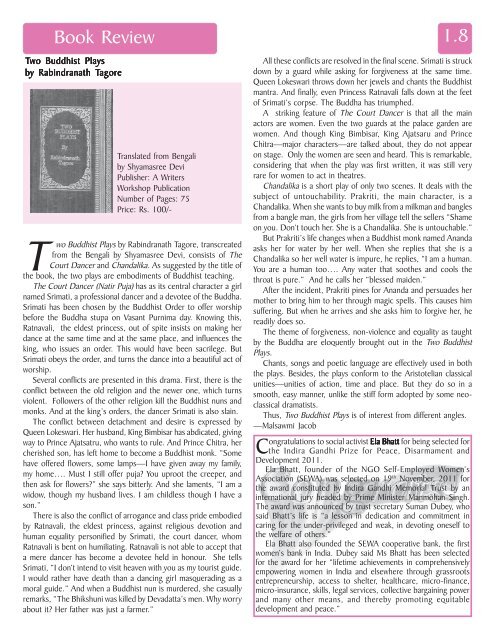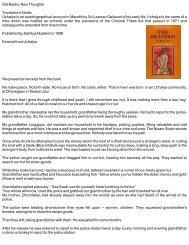SNL25-26_final for print.pmd - sparrow
SNL25-26_final for print.pmd - sparrow
SNL25-26_final for print.pmd - sparrow
- No tags were found...
Create successful ePaper yourself
Turn your PDF publications into a flip-book with our unique Google optimized e-Paper software.
Book ReviewTwo wo Buddhist Playsby Rabindranath TagoreProfileoTranslated from Bengaliby Shyamasree DeviPublisher: A WritersWorkshop PublicationNumber of Pages: 75Price: Rs. 100/-Two Buddhist Plays by Rabindranath Tagore, transcreatedfrom the Bengali by Shyamasree Devi, consists of TheCourt Dancer and Chandalika. As suggested by the title ofthe book, the two plays are embodiments of Buddhist teaching.The Court Dancer (Natir Puja) has as its central character a girlnamed Srimati, a professional dancer and a devotee of the Buddha.Srimati has been chosen by the Buddhist Order to offer worshipbe<strong>for</strong>e the Buddha stupa on Vasant Purnima day. Knowing this,Ratnavali, the eldest princess, out of spite insists on making herdance at the same time and at the same place, and influences theking, who issues an order. This would have been sacrilege. ButSrimati obeys the order, and turns the dance into a beautiful act ofworship.Several conflicts are presented in this drama. First, there is theconflict between the old religion and the newer one, which turnsviolent. Followers of the other religion kill the Buddhist nuns andmonks. And at the king’s orders, the dancer Srimati is also slain.The conflict between detachment and desire is expressed byQueen Lokeswari. Her husband, King Bimbisar has abdicated, givingway to Prince Ajatsatru, who wants to rule. And Prince Chitra, hercherished son, has left home to become a Buddhist monk. “Somehave offered flowers, some lamps—I have given away my family,my home…. Must I still offer puja? You uproot the creeper, andthen ask <strong>for</strong> flowers?” she says bitterly. And she laments, “I am awidow, though my husband lives. I am childless though I have ason.”There is also the conflict of arrogance and class pride embodiedby Ratnavali, the eldest princess, against religious devotion andhuman equality personified by Srimati, the court dancer, whomRatnavali is bent on humiliating. Ratnavali is not able to accept thata mere dancer has become a devotee held in honour. She tellsSrimati, “I don’t intend to visit heaven with you as my tourist guide.I would rather have death than a dancing girl masquerading as amoral guide.” And when a Buddhist nun is murdered, she casuallyremarks, “The Bhikshuni was killed by Devadatta’s men. Why worryabout it? Her father was just a farmer.”1.8All these conflicts are resolved in the <strong>final</strong> scene. Srimati is struckdown by a guard while asking <strong>for</strong> <strong>for</strong>giveness at the same time.Queen Lokeswari throws down her jewels and chants the Buddhistmantra. And <strong>final</strong>ly, even Princess Ratnavali falls down at the feetof Srimati’s corpse. The Buddha has triumphed.A striking feature of The Court Dancer is that all the mainactors are women. Even the two guards at the palace garden arewomen. And though King Bimbisar, King Ajatsaru and PrinceChitra—major characters—are talked about, they do not appearon stage. Only the women are seen and heard. This is remarkable,considering that when the play was first written, it was still veryrare <strong>for</strong> women to act in theatres.Chandalika is a short play of only two scenes. It deals with thesubject of untouchability. Prakriti, the main character, is aChandalika. When she wants to buy milk from a milkman and banglesfrom a bangle man, the girls from her village tell the sellers “Shameon you. Don’t touch her. She is a Chandalika. She is untouchable.”But Prakriti’s life changes when a Buddhist monk named Anandaasks her <strong>for</strong> water by her well. When she replies that she is aChandalika so her well water is impure, he replies, “I am a human.You are a human too…. Any water that soothes and cools thethroat is pure.” And he calls her “blessed maiden.”After the incident, Prakriti pines <strong>for</strong> Ananda and persuades hermother to bring him to her through magic spells. This causes himsuffering. But when he arrives and she asks him to <strong>for</strong>give her, hereadily does so.The theme of <strong>for</strong>giveness, non-violence and equality as taughtby the Buddha are eloquently brought out in the Two BuddhistPlays.Chants, songs and poetic language are effectively used in boththe plays. Besides, the plays con<strong>for</strong>m to the Aristotelian classicalunities—unities of action, time and place. But they do so in asmooth, easy manner, unlike the stiff <strong>for</strong>m adopted by some neoclassicaldramatists.Thus, Two Buddhist Plays is of interest from different angles.—Malsawmi JacobCongratulations to social activist Ela Bhatt <strong>for</strong> being selected <strong>for</strong>the Indira Gandhi Prize <strong>for</strong> Peace, Disarmament andDevelopment 2011.Ela Bhatt, founder of the NGO Self-Employed Women’sAssociation (SEWA) was selected on 19 th November, 2011 <strong>for</strong>the award constituted by Indira Gandhi Memorial Trust by aninternational jury headed by Prime Minister Manmohan Singh.The award was announced by trust secretary Suman Dubey, whosaid Bhatt’s life is “a lesson in dedication and commitment incaring <strong>for</strong> the under-privileged and weak, in devoting oneself tothe welfare of others.”Ela Bhatt also founded the SEWA cooperative bank, the firstwomen’s bank in India. Dubey said Ms Bhatt has been selected<strong>for</strong> the award <strong>for</strong> her “lifetime achievements in comprehensivelyempowering women in India and elsewhere through grassrootsentrepreneurship, access to shelter, healthcare, micro-finance,micro-insurance, skills, legal services, collective bargaining powerand many other means, and thereby promoting equitabledevelopment and peace.”




